Light Sources and Lamp Characteristics
One of the first decisions in the design of a good lighting system is the choice of a light source. A number of light sources are available, each with its own unique combination of operating characteristics.
A few of the lamp characteristics that a lighting designer should consider when choosing a light source include efficacy, or lumens per watt; color; lamp life; and lamp lumen depreciation, or the percent of output that a lamp loses over its life.
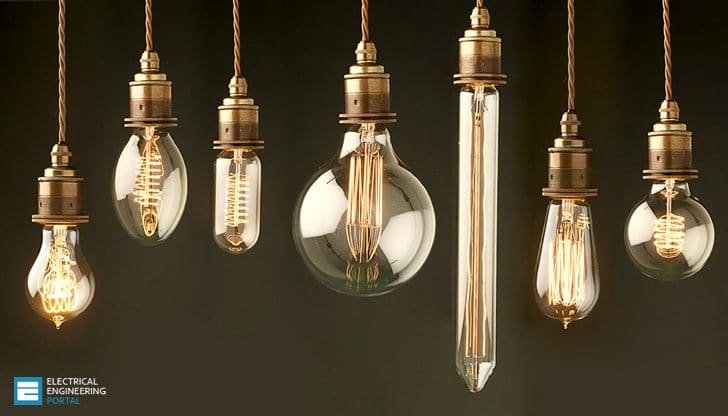
Although there are hundreds of lamps on the market today, they can be categorized by construction and operating characteristics into three main groups: incandescent, fluorescent and high intensity discharge (HID). HID lamps can be grouped into three major classes: high pressure sodium, metal halide and mercury vapor.
Another type of lamp, low pressure sodium (LPS), shares some characteristics of HID lamps. Induction lamps are a special type of fluorescent.
Incandescent
An incandescent filament lamp is the light source most commonly used in residential lighting. Light is produced in this source by a wire or filament being heated to incandescence (emitting light) by a flow of current through it.
The short life and low efficacy (lumens per watt) of this source limit its use mostly to residential and decorative commercial lighting.
Efficacy varies with wattage and filament type, but generally ranges from 15 to 25 lumens per watt for general service lamps.

The incandescent source does, however, produce light in a well accepted warm tone. It is more convenient than other light sources because it can be run directly on line current and therefore does not require a ballast. It can also be dimmed using relatively simple equipment. It is available in different bulb sizes, shapes and distributions to add a decorative touch to an area.
Fluorescent
The fluorescent lamp produces light by activating selected phosphors on the inner surface of the bulb with ultraviolet energy, which is generated by a mercury arc. Because of the characteristics of a gaseous arc, a ballast is needed to start and operate fluorescent lamps.
The advantages of the fluorescent light source include improved efficacy and longer life than incandescent lamps.
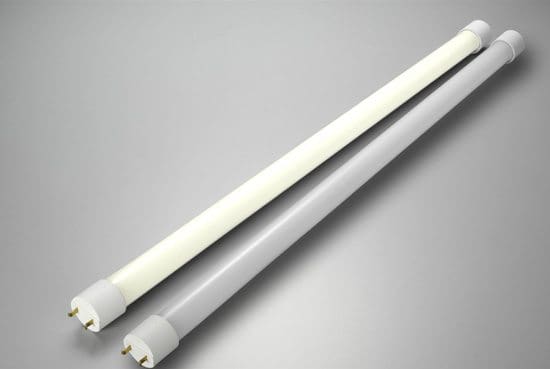
Efficacies for fluorescent lamps range anywhere from 50 to 100 lumens per watt. Their low surface brightness and heat generation make them ideal for offices and schools where thermal and visual comfort are important.
Induction
Induction lamps are electrodeless fluorescent lamps driven by high-frequency current, typically between 250kHz and 2.65mHz, usually via an external generator. They are available in limited wattages and are known for exceptionally long service life: up to 100,000 hours.
Lamp efficacies typically range from 64 to 88 lumens per watt. Color rendition with induction lamps is very good.
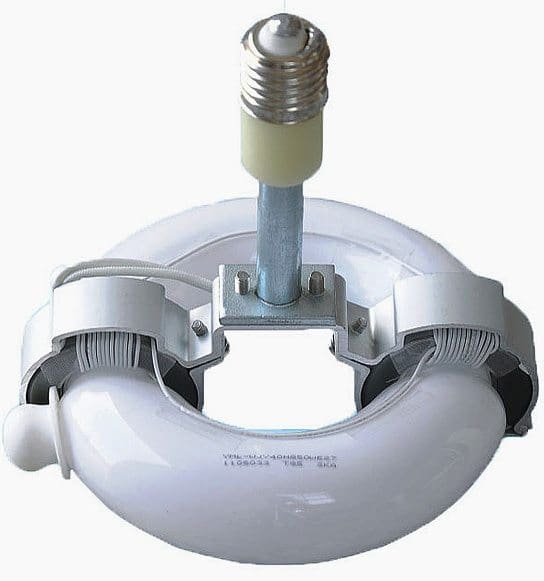
Although not easily optically controllable in a luminaire because of the large lamp size, induction lighting is often employed in applications where luminaires may be very difficult to access or where maintenance costs are a strong factor in the lighting design and installation. Initial system purchasing costs are high compared to the best HID or fluorescent systems.
High Intensity Discharge (HID) and LPS
High intensity discharge sources include:
- Mercury vapor,
- Metal halide, and
- High pressure sodium (HPS) lamps.
Light is produced in HID and low pressure sodium (LPS) sources through a gaseous arc discharge using a variety of elements. Each HID lamp consists of an arc tube which contains certain elements or mixtures of elements which, when an arc is created between the electrodes at each end, gasify and generate visible radiation.

The major advantages of HID sources are their high efficacy in lumens per watt, long lamp life and point-source characteristic for good light control.
Disadvantages include the need for a ballast to regulate lamp current and voltage as well as a starting aid for HPS and some MH and the delay in restriking after a momentary power interruption.
Mercury Vapor (MV)
The mercury vapor source was the first HID lamp developed, filling the need for a more efficient, yet compact, high output lamp. When first developed, the major disadvantage of this lamp was its poor color rendition. The color of the deluxe white lamp is somewhat improved through use of a phosphor coated bulb wall.
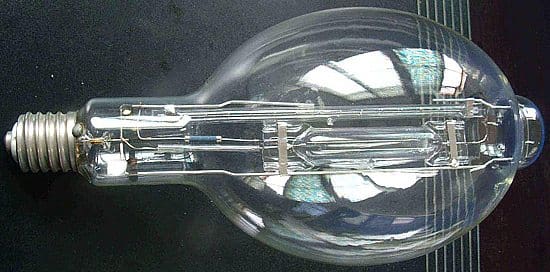
The life of mercury vapor lamps is good, averaging 24,000 hours for most larger wattage lamps. However, because the output diminishes so greatly over time, economical operational life is often much shorter. Efficacy ranges from 30 to 60 lumens per watt, with the higher wattages being more efficacious than the lower wattages.
As with other HID lamps, the starting of a mercury vapor lamp is not immediate. Starting time is short, though, taking 4-7 minutes to achieve maximum output depending upon the ambient temperature.
High Pressure Sodium (HPS)
In the 1970s, as increasing energy costs placed more emphasis on the efficiency of lighting, high pressure sodium lamps (developed in the 1960s) gained widespread usage. With efficacies ranging from 80 to 140 lumens per watt, these lamps provide about 7 times as much light per watt as incandescent and about twice as much as some mercury or fluorescent.
The efficacy of this source is not its only advantage. An HPS lamp also offers the longest life (24,000+ hrs.) and the best lumen maintenance characteristics of all HID sources.
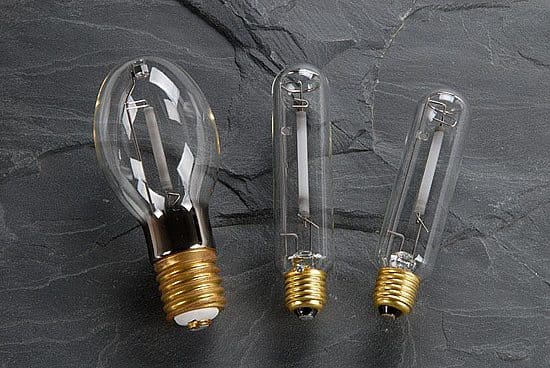
The major objection to the use of HPS is its yellowish color and low color rendition. It is ideal mainly for some warehouse and outdoor applications.
Metal Halide (MH)
Metal halide lamps are similar in construction to mercury lamps with the addition of various other metallic elements in the arc tube. The major benefits of this change are an increase in efficacy to 60 to 100 lumens per watt and an improvement in color rendition to the degree that this source is suitable for commercial areas.
Light control of a metal halide lamp is also more precise than that of a deluxe mercury lamp since light emanates from the small arc tube, not the total outer bulb of the coated lamp.
Pulse-start metal halide lamps have several advantages over standard (probe-start) metal halide:
- Higher efficacy (110 lumens per watt),
- Longer life, and
- Better lumen maintenance.
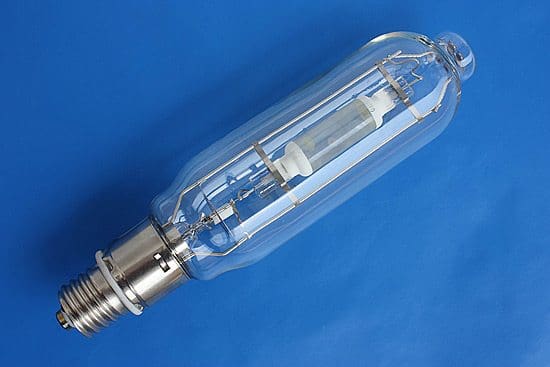
A disadvantage of the metal halide lamp is its shorter life (7,500 to 20,000 hrs) as compared to mercury and high pressure sodium lamps.
Starting time of the metal halide lamp is approximately the same as for mercury lamps. Restriking after a voltage dip has extinguished the lamp, however, can take substantially longer, ranging from 4 to 12 minutes depending on the time required for the lamp to cool.
Low Pressure Sodium (LPS)
Low pressure sodium offers the highest initial efficacy of all lamps on the market today, ranging from 100 to 180 lumens per watt. However, because all of the LPS output is in the yellow portion of the visible spectrum, it produces extremely poor and unattractive color rendition.
Control of this source is more difficult than with HID sources because of the large size of the arc tube.

The average life of low pressure sodium lamps is 18,000 hours. While lumen maintenance through life is good with LPS, there is an offsetting increase in lamp watts, reducing the efficacy of this lamp type with use.
SOURCE // Holophane Canada – The Fundamentals Of Lighting











May LEDs also be chosen as light sources?
Of course! LED is today one of the most used lifgt sources for various applications.